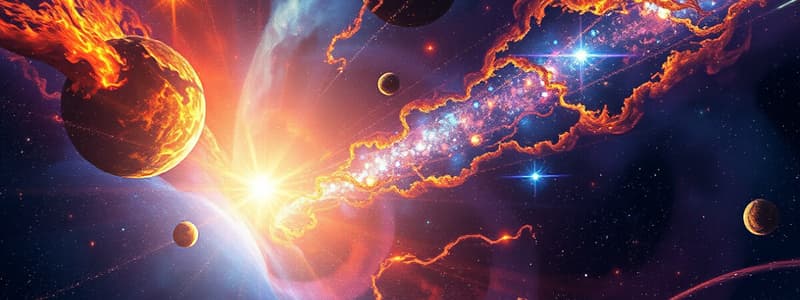Podcast
Questions and Answers
What do astronomers mean by the Big Bang?
What do astronomers mean by the Big Bang?
The event that marked the beginning of the expansion of the universe.
How many galaxies are there in the observable universe?
How many galaxies are there in the observable universe?
Roughly (within a factor of 10) the same as the number of stars in our galaxy.
The Sun is mainly made of?
The Sun is mainly made of?
Hydrogen and helium.
What does 1.1 The Scale of the Universe refer to?
What does 1.1 The Scale of the Universe refer to?
How big is the universe?
How big is the universe?
Which of the following has your 'address' in the correct order?
Which of the following has your 'address' in the correct order?
About where is our solar system located within the Milky Way Galaxy?
About where is our solar system located within the Milky Way Galaxy?
What do we mean when we say that the universe is expanding?
What do we mean when we say that the universe is expanding?
One light-hour is the distance that light travels in an hour. How far is this, in kilometers?
One light-hour is the distance that light travels in an hour. How far is this, in kilometers?
Suppose we imagine the Sun to be about the size of a grapefruit. What describes the size and distance of Earth on the same scale?
Suppose we imagine the Sun to be about the size of a grapefruit. What describes the size and distance of Earth on the same scale?
On the 1-to-10-billion scale, about how far is it to the nearest stars besides the Sun?
On the 1-to-10-billion scale, about how far is it to the nearest stars besides the Sun?
What is nuclear fusion?
What is nuclear fusion?
Earth is made mostly of metals and rocks. Where did this material come from?
Earth is made mostly of metals and rocks. Where did this material come from?
All galaxies beyond those local to the Milky Way appear to be receding from us.
All galaxies beyond those local to the Milky Way appear to be receding from us.
On a cosmic calendar, in which the history of the universe is compressed into 1 year, when did the dinosaurs become extinct?
On a cosmic calendar, in which the history of the universe is compressed into 1 year, when did the dinosaurs become extinct?
The fact that nearly all galaxies are moving away from us, with more distant ones moving faster, helped us to conclude that:
The fact that nearly all galaxies are moving away from us, with more distant ones moving faster, helped us to conclude that:
The age of our solar system is about:
The age of our solar system is about:
An astronomical unit is:
An astronomical unit is:
Most of the mass in the Milky Way Galaxy is located:
Most of the mass in the Milky Way Galaxy is located:
How long does it take our solar system to complete one orbit around the Milky Way Galaxy?
How long does it take our solar system to complete one orbit around the Milky Way Galaxy?
Patterns of stars in constellations hardly change in appearance over times of even a few thousand years. Why?
Patterns of stars in constellations hardly change in appearance over times of even a few thousand years. Why?
Flashcards are hidden until you start studying
Study Notes
Cosmology and the Universe
- The Big Bang marks the beginning of the universe's expansion.
- The observable universe contains roughly the same number of galaxies as the stars in the Milky Way.
- The universe is continuously expanding, with galaxies moving away from each other.
Structure of the Universe
- Our solar system resides in the Milky Way Galaxy, a massive disk-shaped collection of stars.
- The solar system is located about halfway from the Milky Way's center to its outskirts.
- The "address" of an individual includes: you, Earth, solar system, Milky Way, Local Group, and Local Supercluster.
Size and Scale
- On a scale where the Sun is a grapefruit, Earth is a ballpoint tip located 15 meters away; the nearest stars are thousands of kilometers distant.
- One light-hour equals approximately 1.08 billion kilometers.
- On a 1-to-10-billion scale, the nearest stars are roughly 4,400 kilometers away.
Solar System and Galaxy Composition
- The Sun is primarily composed of hydrogen and helium.
- Earth is made mostly of metals and rocks, originating from heavy elements produced by nuclear fusion in stars.
Galactic Properties
- Most mass in the Milky Way is found in the halo, above and below the galactic disk.
- The solar system takes about 230 million years to complete one orbit around the Milky Way.
Light and Energy Processes
- Nuclear fusion involves lightweight atomic nuclei fusing to form heavier nuclei, a process that powers stars.
Cosmic Timeline
- On a cosmic calendar, dinosaurs became extinct in late December, illustrating the vast timescale of the universe.
- The age of the solar system is approximately one-third that of the universe.
Stellar Patterns
- Constellation patterns remain nearly unchanged over thousands of years due to the vast distances between stars.
Studying That Suits You
Use AI to generate personalized quizzes and flashcards to suit your learning preferences.




